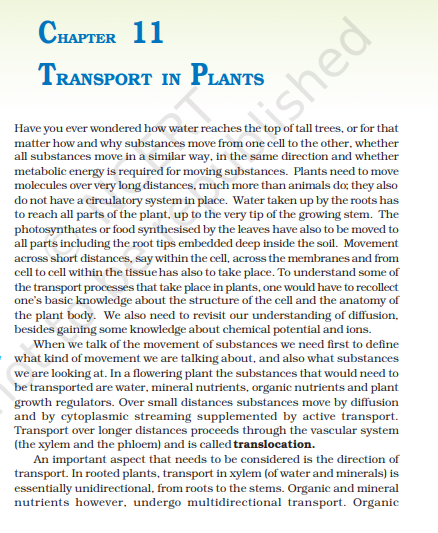‘NCERT Solutions for Class 11 Biology Chapter 11 Transport In Plants’ PDF Quick download link is given at the bottom of this article. You can see the PDF demo, size of the PDF, page numbers, and direct download Free PDF of ‘Ncert Class 11 Biology Chapter 11 Exercise Solution’ using the download button.
Transport In Plants NCERT Textbook With Solutions PDF Free Download

Chapter 11: Transport in Plants
Movement by diffusion is passive and may be from one part of the cell to the other, from cell to cell, or over short distances, say, from the intercellular spaces of the leaf to the outside. No energy expenditure takes place.
In diffusion, molecules move in a random fashion, the net result being substances moving from regions of higher concentration to regions of lower concentration. Diffusion is a slow process and is not dependent on a ‘living system’.
Diffusion is obvious in gases and liquids, but diffusion in solids rather than solids is more likely.
Diffusion is very important to plants since it is the only means for gaseous movement within the plant body. Diffusion rates are affected by the gradient of concentration, the permeability of the membrane separating them, temperature, and pressure.
11.1.2 Facilitated Diffusion
As pointed out earlier, a gradient must already be present for diffusion to occur. The diffusion rate depends on the size of the substances; obviously smaller substances diffuse faster.
The diffusion of any substance across a membrane also depends on its solubility in lipids, the major constituent of the membrane.
Substances soluble in lipids diffuse through the membrane faster. Substances that have a hydrophilic moiety, find it difficult to pass through the membrane; their movement has to be facilitated.
Membrane proteins provide sites at which such molecules are across the membrane.
They do not set up a concentration gradient: a concentration gradient must already be present for molecules to diffuse even if facilitated by the proteins. This process is called facilitated diffusion.
In facilitated diffusion special proteins help move substances across membranes without the expenditure of ATP energy.
Facilitated diffusion cannot cause net transport of molecules from a low to a high concentration – this would require the input of energy. The transport rate reaches a maximum when all of the protein transporters are being used (saturation).
The proteins form channels in the membrane for molecules to pass through. Some channels are always open; others can be controlled.
Some are large, allowing a variety of molecules to cross. The porins are proteins that form huge pores in the outer membranes of the plastids, mitochondria, and some bacteria allowing molecules up to the size of small proteins to pass through.
11.1.2.1 Passive symports and antiports
Some carrier or transport proteins allow diffusion only if two types of molecules move together.
In a symport, both molecules cross the membrane in the same direction; in an antiport, they move in opposite directions When a molecule moves across a membrane independent of other molecules, the process is called uniport.
11.1.3 Active Transport
Active transport uses energy to pump molecules against a concentration gradient. Active transport is carried out by membrane proteins.
Hence different proteins in the membrane play a major role in both active as well as passive transport.
Pumps are proteins that use energy to carry substances across the cell membrane. These pumps can transport substances from a low concentration to a high concentration (‘uphill’
transport).
The transport rate reaches a maximum when all the protein transporters are being used or are saturated.
Like enzymes, the carrier protein is very specific in what it carries across the membrane. These proteins are sensitive to inhibitors that react with protein side chains.
| Author | NCERT |
| Language | English |
| No. of Pages | 21 |
| PDF Size | 3.8 MB |
| Category | Biology |
| Source/Credits | ncert.nic.in |
NCERT Solutions Class 11 Biology Chapter 11 Transport in Plants
1. What are the factors affecting the rate of diffusion?
Solution:
Factors affecting the rate of diffusion are:
- Gradient of concentration
- The permeability of the membrane separating them
- Temperature
- Pressure
2. What are porins? What role do they play in diffusion?
Solution:
The porins are proteins that form large pores in the outer membranes of the plastids, mitochondria, and some bacteria. The large pores allow molecules up to the size of small proteins to pass through. Hence, they promote diffusion.
3. Describe the role played by protein pumps during active transport in plants.
Solution:
Protein pumps use energy to carry substances across the cell membrane. These protein pumps take the substance from a region of lower concentration to a region of higher concentration.
They take part in transportation with the help of energy against the concentration gradient, wherein the energy is supplied by ATP.
The protein pumps, upon getting activated with energy picks up solute particles from the outside to transfer them to the inside of the cytoplasm. When all the protein pumps are getting used, the transport rate reaches its maximum.
Active transport is the transport of ions across the membrane of plants through these protein pumps involving energy.
4. Explain why pure water has the maximum water potential.
Solution:
Pure water has the maximum water potential because they have a kinetic energy of its own and they remain in constant random motion.
The water molecules in pure water possess maximum kinetic energy which decreases with the addition of solutes, subsequently, the free energy of the water molecules gets decreased. Hence, pure water is said to have maximum water potential.
NCERT Class 11 Biology Textbook Chapter 11 Transport in Plants With Answer PDF Free Download
